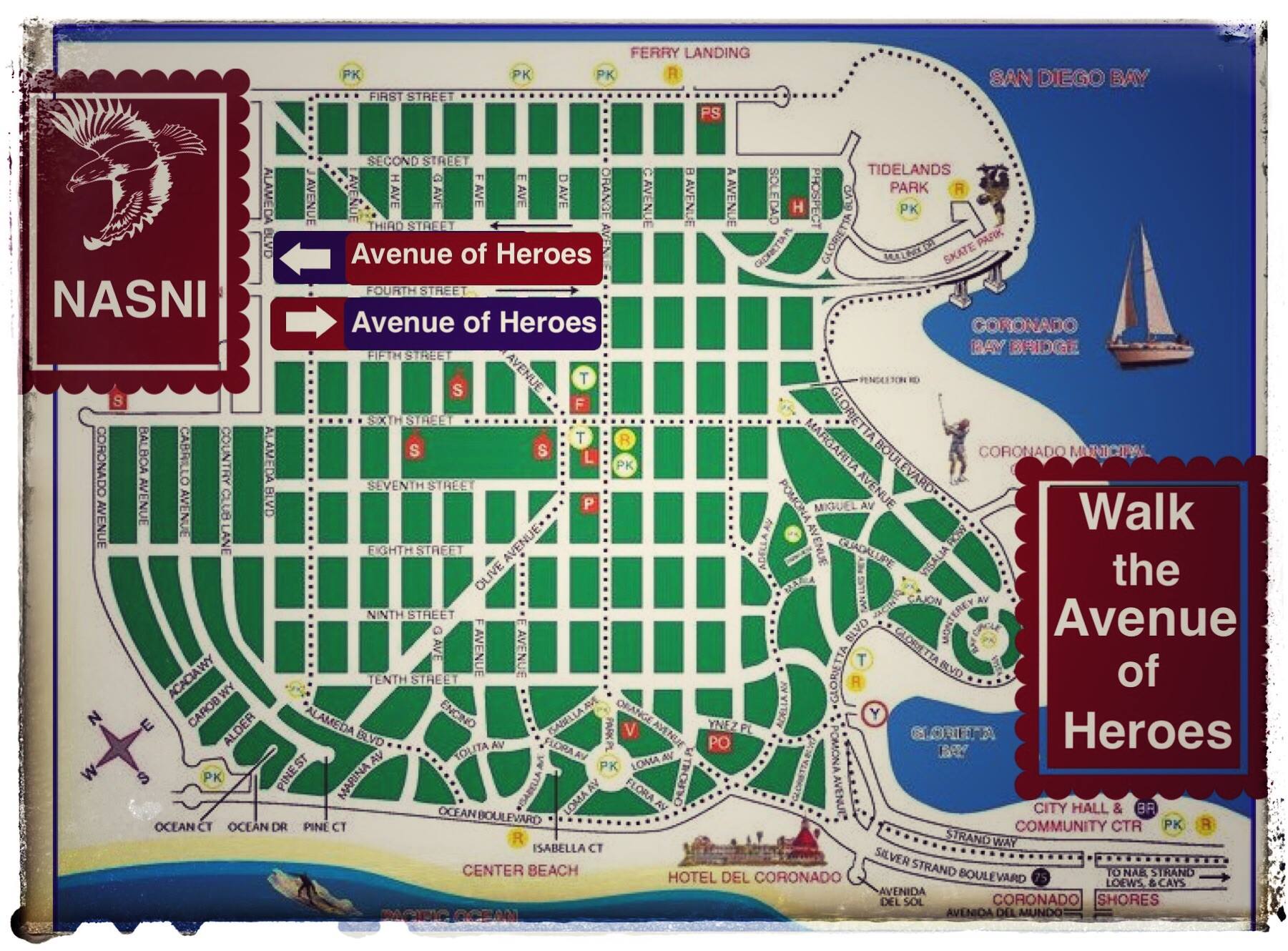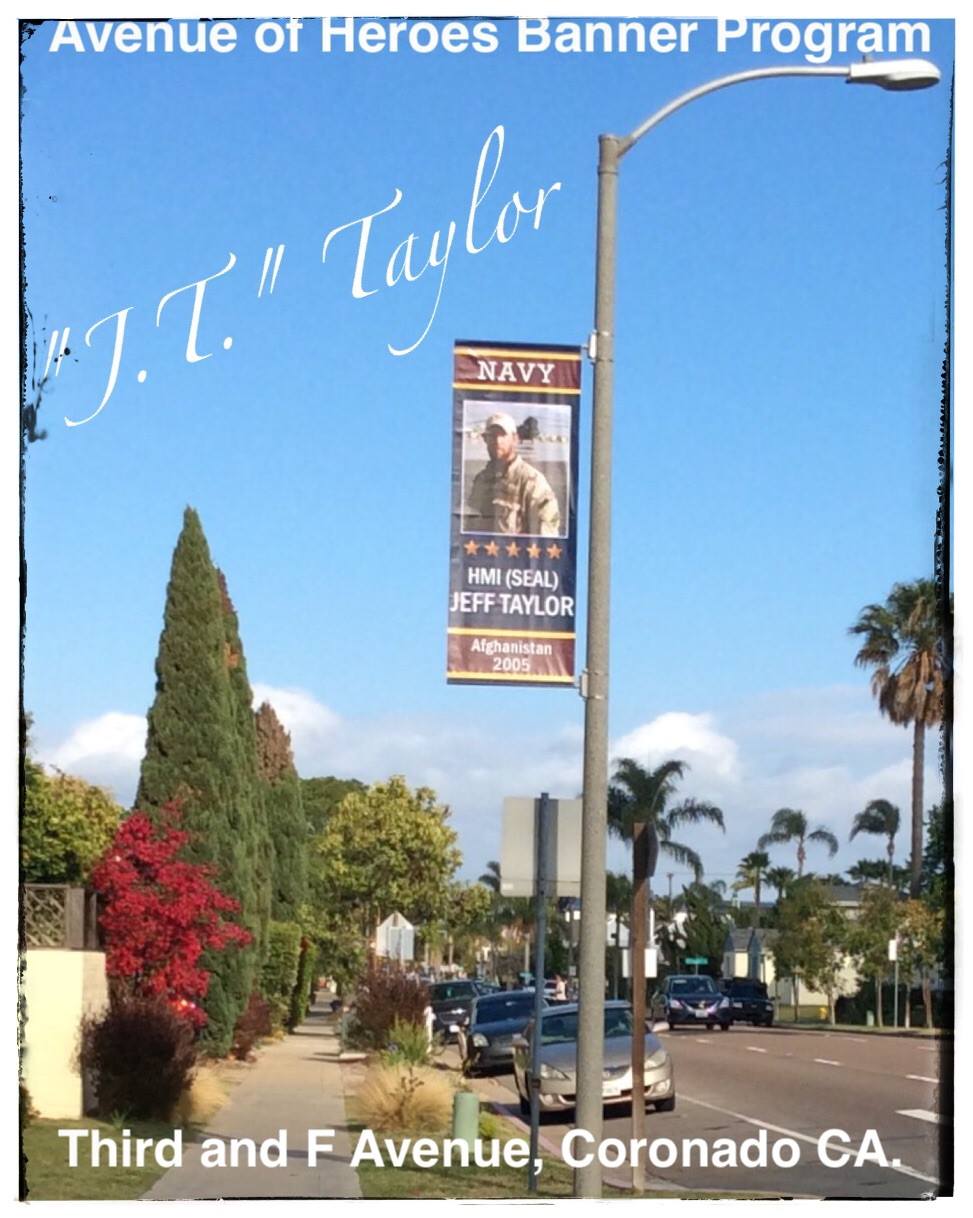
How does a neighborhood, considered to have the busiest highway for its length in the country, turn the tide and become a pride of Coronado again? The TAF (Third and Fourth Streets) group asserted that one challenge, the Navy commuter traffic, could actually become their own “Crown.”
When the concept of an “Avenue of Heroes,” (to honor the significant military route of Third and Fourth Streets) was brought before the Coronado Transportation Commission (CTC) in January 2014, Admiral Giorgione, who was serving as Chairman of the commission, contacted Toni McGowan, who presented the initial concept. The Admiral and Toni took a walk down Third Street to discuss the idea further. He suggested that the Hometown Heroes Banner Program (that was in place in Huntington Beach) might be a nice feature to mark the roadway as a true “Avenue of Heroes.” It consisted of banners with head shots of past and present service members, affixed to light standards along the roadway.
Following that meeting, just over a year ago, a small group of Coronado neighbors got together at Jeanie Peterson’s home. Their numbers were small, but their plans were large to recapture Coronado’s charm along the bustling streets of Third and Fourth. In attendance were, Jeanie and Mr. Peterson, Amanda Gafford (Meyers), Frank Spitzer, and Toni McGowan. Councilman Richard Bailey also attended that first meeting and encouraged nurturance of their vision of transforming Third and Fourth Streets, which were primarily known for their traffic, into the flagships of Coronado.
 Thus, the “Third and Fourth Streets Planning group,” affectionately known as “TAF,” was formed. TAF recognized that Coronado is in essence a “Navy Town.” However, with further research, they soon found it was so much more that that. They wished to honor all of the military branches that formed today’s Naval Air Station North Island (NASNI), along with the current service members who suffer the daily traffic in support of our country.
Thus, the “Third and Fourth Streets Planning group,” affectionately known as “TAF,” was formed. TAF recognized that Coronado is in essence a “Navy Town.” However, with further research, they soon found it was so much more that that. They wished to honor all of the military branches that formed today’s Naval Air Station North Island (NASNI), along with the current service members who suffer the daily traffic in support of our country.
The goal was to honor military sacrifice, and reclaim and revive the historic beauty of our town, and the neighborhoods extending from the Coronado Bridge to Naval Air Station North Island (NASNI). In addition, was a concern for safety along the busy thoroughfares that began in 1969, with the completion of the Coronado Bay Bridge.
Since the Coronado Bridge was christened, the new entry held a double-edged sword. On the one side, it made travel to and from Coronado fast and efficient and created an iconic arc that would become a trademark of the San Diego Bay. The Bridge also caused property values on Coronado to double overnight due to improved access. On the down side, it changed two quiet neighborhoods; Barrio/Logan, and Third and Fourth Streets of Coronado.
Barrio Logan took the devastation of their residential community and turned it into an award winning, culturally significant neighborhood. Even after nearly 50-years, Coronado found no way to reframe their devastation. And, as a result, the entire city has wrestled to adapt, avoid, detour, and deny, the ever increasing traffic flowing in and out of Coronado, by Navy and resident commuters, commerce, and by tourism.
On top of slicing the island in half, dividing beach from bay, residents from the only hospital and children from schools, the congested roadway became paralyzed by a jurisdictional quagmire; involving Caltrans, the City of Coronado, Port District, two State Highways and a fragmented Scenic Highway, the United States Navy, specific truck route designations and restrictions, the Coronado Police Department, California Highway Patrol, Military Police, and Harbor Police. This quagmire left no single entity with the responsibility or will to improve things, resulting in a state of degradation and decay, that puts everyone who drives or crosses the roadway, at risk.
The process for transformation began. An article was written in conjunction with USD Historian, Shoshana Lazik-Jones. Door to door handouts were delivered, TAF launched of two-facebook pages (Third and Fourth Streets Planning community and Avenue of Heroes). Concurrently, John Tato, Coronado Transportation Commissioner (CTC), launched efforts to implement modern Traffic Calming engineering, by initiating the Third and Fourth Streets Study.
TAF members were surprised, but not discouraged, when there was apathy, and a general opinion that those who live on Third and Fourth Streets should simply accept their circumstances, after all, they “chose to live there.”
 There was controversy, especially over the Hometown Heroes Banner concept. Not all of the residents liked the idea of banners for varying reasons. Concerns included banners “cluttering” the roadway, or “causing accidents” by distracting drivers. Some felt the roadway was already “over-signed.” For this reason, TAF decided the banners would only be installed on SR282, from Orange Avenue to NASNI. Others stated it “reminded them of war,” or the banners might “block their view” of the skyline, or may deteriorate with time, and then look “tacky.” Some felt they should go on Orange Avenue instead, as it was a “nicer street.”
There was controversy, especially over the Hometown Heroes Banner concept. Not all of the residents liked the idea of banners for varying reasons. Concerns included banners “cluttering” the roadway, or “causing accidents” by distracting drivers. Some felt the roadway was already “over-signed.” For this reason, TAF decided the banners would only be installed on SR282, from Orange Avenue to NASNI. Others stated it “reminded them of war,” or the banners might “block their view” of the skyline, or may deteriorate with time, and then look “tacky.” Some felt they should go on Orange Avenue instead, as it was a “nicer street.”
There were also many supporters. Navy widows were the first to actively support the concept. Who, upon hearing the concerns of the community at city meetings or internet comments, expressed heartache that Coronado residents would refer to military service members images proudly displayed as “clutter.” The United States Navy, Coronado VFW, the Coronado Historical Association, and local residents, both military and civilian, to name a few, became advocates.
The project gained real traction with the talents of TAF members. Graphic artist John Weimann, created a logo for the Avenue of Heroes. PAWs joined with TAF at the Park events to raise awareness led by Amanda Gafford. Eva Yakutis lent her skills in community development and neighborhood advocacy. Jerry Greenspan shared his knowledge. Retired Master Chief, Darlene Parker, assisted with publications, in terms of military language. Authors, speakers, and others came forward to help. Momentum was building.
Finally, a proposal was written by Eva Yakutis, and presented to Coronado City Council by Council-member Bailey to designate Third and Fourth Streets as the “Avenue of Heroes.” The proposition passed in July of 2014, with the City of Coronado staff at the helm of administering the program and funding the banners, just as they do for other banners on Orange Avenue.
 The proposal was unanimously supported by Coronado City Council.
The proposal was unanimously supported by Coronado City Council.
Then, on November 11, 2014, the neighborhood celebrated with supporters, the City of Coronado, Council-members, the VFW, Coronado Historical Association, and the United States Navy, with Captain Sund offering space over the “Blue-Line” for the event. On that date, the navy placed the first two Banners at the Third Street Gate entry, Vice Admiral Stockdale (POW-Viet Nam), and Lt. Theodore Ellyson, Naval Pilot no. 1. Also at that location, was a follow-up celebration at the historic home of Glenn Curtiss, now owned by the Burgos family, and winner of the prestigious Gem Award. The Stockdale family, and Mrs. Stockdale, honored the event with their attendance.
Now, in spite of initial challenges, the next phase of the “Avenue of Heroes” is rolling out, the Heroes’ Banners. The program is managed primarily by Coronado Assistant Manager, Tom Ritter and Stephanie Lang. The Committee consists of two-TAF residents, John Tato and Mike Turner, two-Veterans of Foreign Wars members, Commander Chuck Lucas and Vice Commander Lee Fulmer, and two-Coronado Historical Association members, Executive Director Bruce Linder and Board Member Millie Creager. Everyone has worked tirelessly, pouring through applications and honing program details, ultimately selecting 16-Coronado residents of the highest caliber from different branches and eras of the United States Armed Forces, who were residents of Coronado.
These heroes are, or were, our Coronado neighbors. Their stories cover 100+ years of military heroism in Coronado.
The Coronado Scribes, and other local writers, plus the Veteran’s Writer’s Group in North County, San Diego, set out to write each of the banner recipient’s biographies. These are stories for children and adults of Coronado and beyond, that will form a fresh memory and meaning to their service.
The Crown of Coronado is most often thought of as the Hotel Del, but TAF residents assert, there is another, equally romantic history, that is also rich in stories of risk taking visionaries. It is unfolding along the “Avenue of Heroes” neighborhood, right now!
The Banner Committee has selected the following Coronadans for banners. These will be displayed for six-months, from Memorial Day to Veterans’ Day. They will then be replaced by a new group of heroes.
Please welcome the first 18-bannerees with a nice stroll. And be sure to read their brief biographies in the Coronado Eagle Journal and on eCoronado.com over the coming weeks to share their experiences of service to country, and to our city.
List of Coronado Resident Banner Recipients, May, 2015
1. Army:
Sgt. Rice
2. Navy:
Admiral Spruance
3. USMC:
Lt. General Mulcahy
4. Navy:
Rear Admiral Prout
5. Navy:
Captain Volpi
6. Army:
Colonel Runyon
7. Navy:
Commander Lewis
8. Navy:
HMI SEAL Taylor
9. Navy:
Ensign Lowthian
10: Army:
1st Lt. Lunt
11. Army:
Colonel Kenney
12. USMS:
Major General Pendleton
13. Navy:
LCDR Engel
14. Navy:
Rear Admiral Ramage
15. Navy:
SOC SEAL Cavner
16. Navy:
Vice Admiral Martin
On base:
17. Navy:
Vice Admiral Stockdale
18. Navy:
Commander Ellyson
Have someone to nominate?
Download Application Form Here:
http://www.coronado.ca.us/egov/documents/1415130831_95342.pdf
If you need help gathering documents, TAF and Avenue of Heroes can help.




